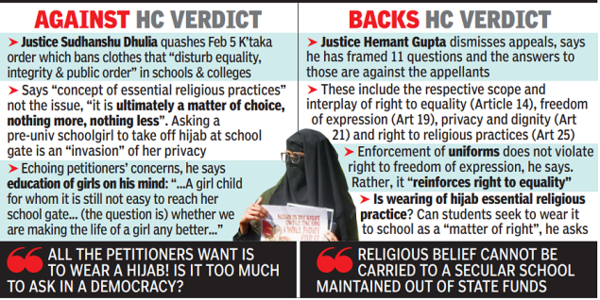The two judges did not agree. The verdict of the Supreme Court in the Hijab case also came in a fragmented form. A two-member bench of Justice Hemant Gupta ruled against wearing hijab in secular educational institutions. Justice Sudhanshu Dhulia commented, “Wearing hijab is completely a matter of preference that is personal. Is that too much to ask for in a democracy?”
Next step for the case
The case will now go to a higher bench. Chief Justice U U Lalit will constitute that bench. Until the case is settled there, the Karnataka High Court judgment remains in place. In other words, the ban on hijab in educational institutions there continues.

In March, the Karnataka High Court ruled that hijab is not an integral part of the Islamic religion. So, it is not permissible to wear a hijab in violation of the dress code of the educational institution. Muslim petitioners came to the Supreme Court against this verdict. After a lengthy hearing, Justice Gupta ruled in favor of dismissing their petition yesterday. Justice Dhulia said ‘difference with respect’. Karnataka Government Education Minister B. C. Nagesh Roy said after the hearing, “As a democratic government we are bound to accept whatever the apex court says. But when women around the world are protesting against wearing the hijab and veil, I expected a better verdict.”
Disagreement between judges
In the Supreme Court yesterday, two judges not only disagreed, but both gave strong arguments in favor of their respective opinions. Justice Gupta said there were 11 questions before him. For example, whether the case should go to a constitutional bench, whether banning hijab violates the right to practice religion under Article 25 of the Constitution, whether the Karnataka government’s ban on hijab interferes with fundamental rights, whether wearing hijab is an integral part of Islamic religion, whether the college can introduce a dress code for its students etc.
According to Justice Gupta, in none of these questions, the argument for wearing the hijab seems irrefutable. According to him, allowing a religious community to carry its religious symbols in a government-funded secular educational institution is ‘the opposite of secularism’. The state certainly has the right to ask students to follow a secular dress code in government-run educational institutions.
Justice Dhulia’s opinion is completely different. Hijab, he argues, may or may not be part of religion. Asking a girl to remove her hijab before entering an educational institution is an invasion of her personal space. A blow to her dignity and ideals of secularism. This violates Articles 19 (1-A), 21, and 25 (1) of the Constitution.
Justice Dhulia felt that insisting on hijab could be harmful in terms of women’s education. He said, “Hijab is one of the excuses to go to school in a very conservative family. A girl child in rural India faces a lot of problems. Keeping that in mind, my question is, just because a girl is wearing a hijab, we are making her life more difficult by depriving her of the light of education. No?”
